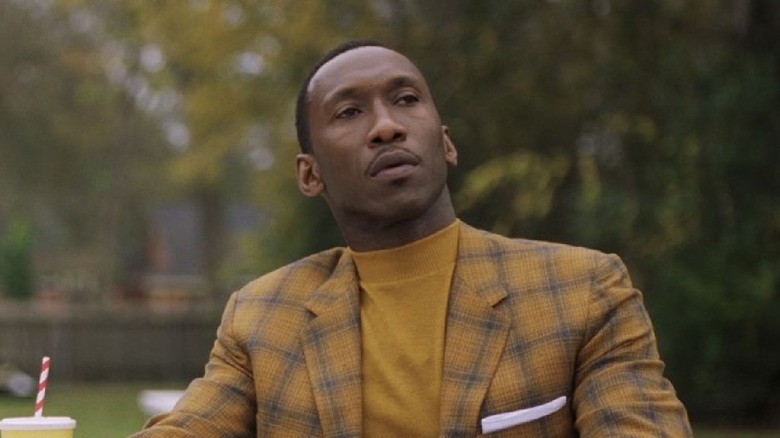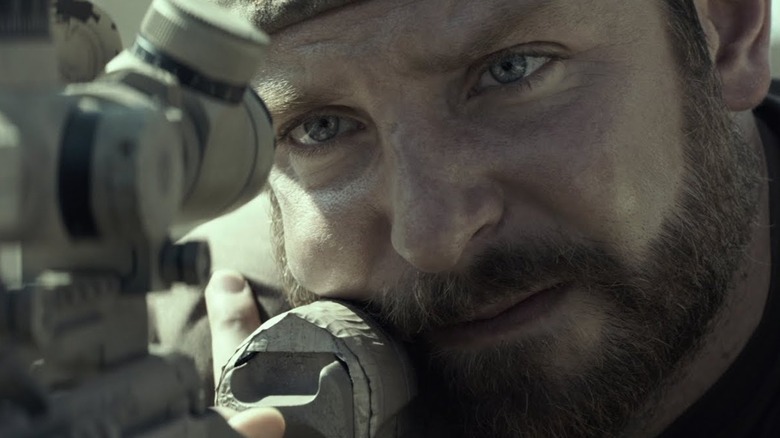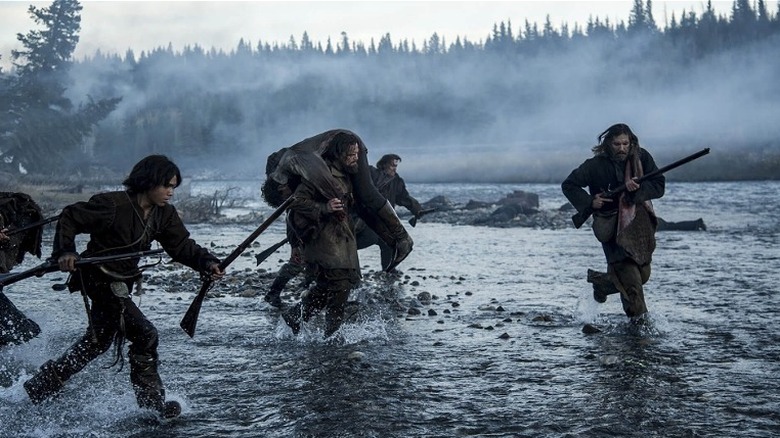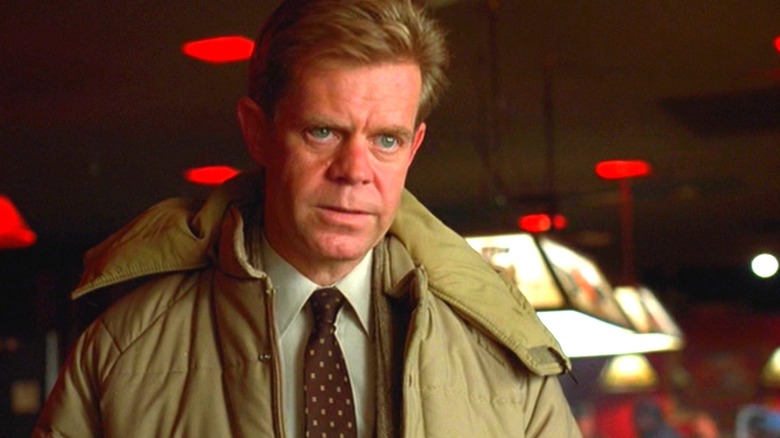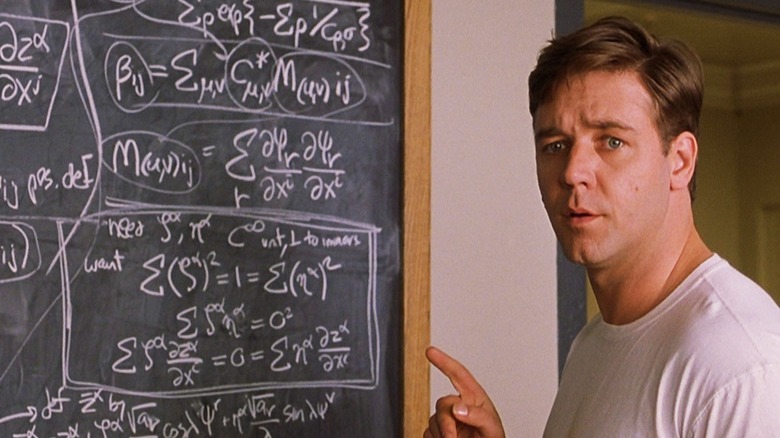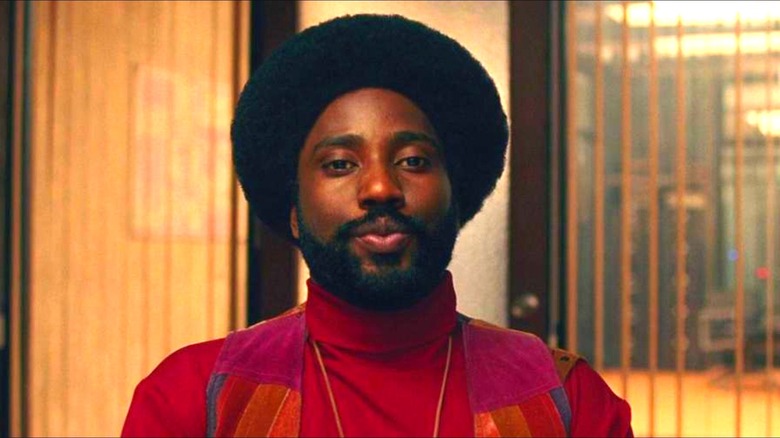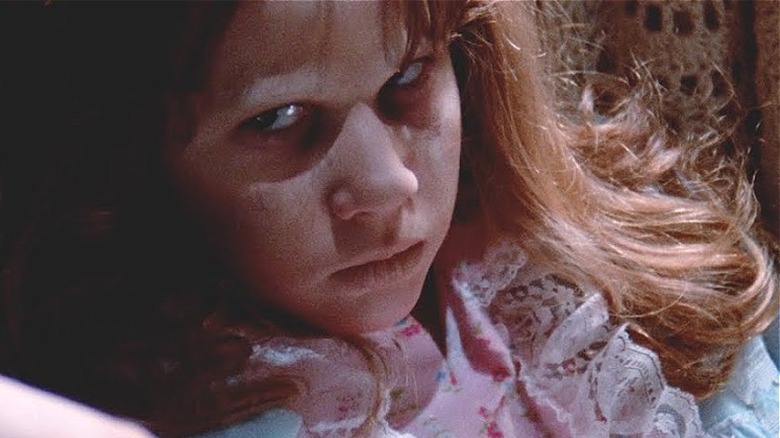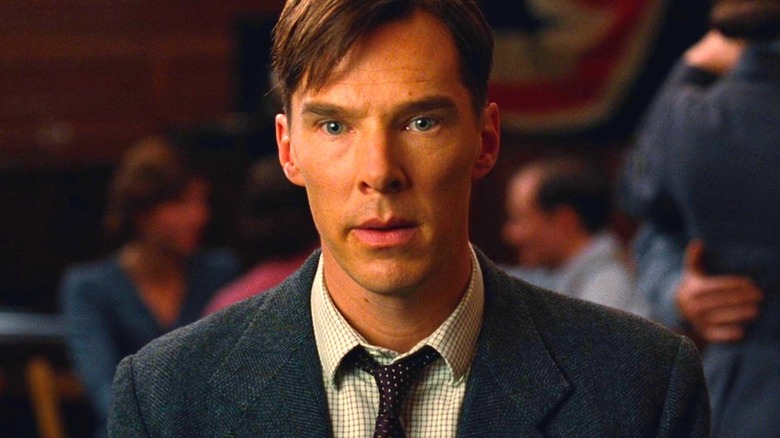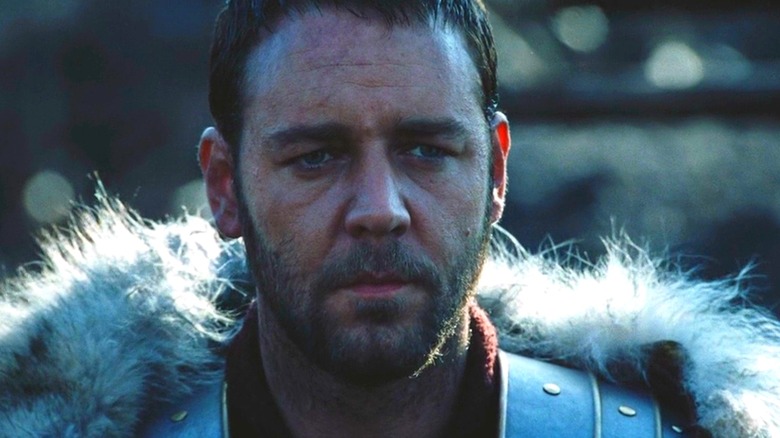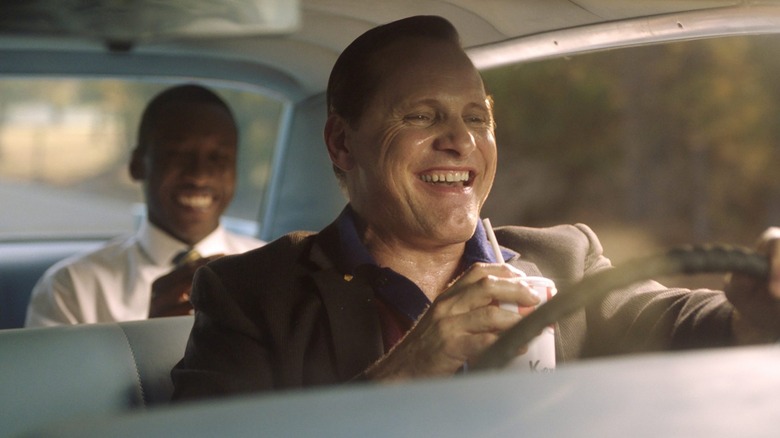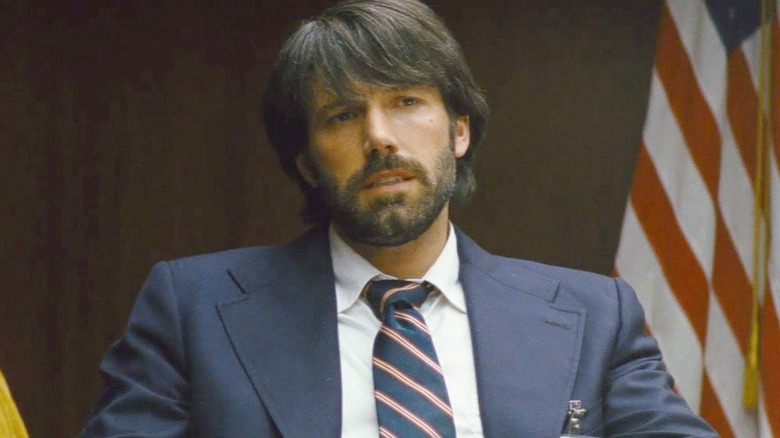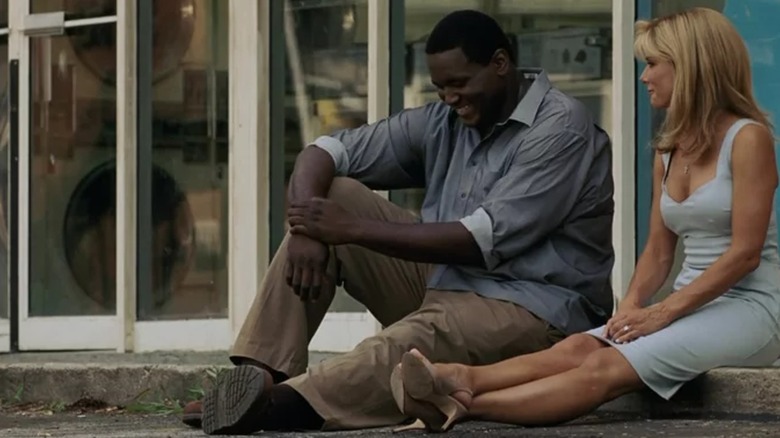Oscar-Winning Movies That Were Based On Total Lies
Hollywood has been churning out movies for over a century, and the Academy of Motion Picture Arts and Sciences has been handing out golden statues for much of that time. The Oscars tend to go to movies with realistic stories, amazing special effects, unique characters, and much more. When a film takes home a statue, it elevates it, often furthering the careers of everyone involved.
One genre of film that the Academy has always been relatively favorable to are movies based on real people and events. Historical dramas, biopics, and movies about wars tend to do well at the Oscars, and while that brings those films a lot of attention, it often shines a light on the many differences between the film and real life.
Filmmakers often make changes to the story for artistic reasons or to make a character more interesting. It happens all the time, and for the most part, the audience can forgive a gender swap here or the merging of several people into one character there. On the other hand, the films below are all based on something real, but the story, characters, or events are so different that much of the content is — whether intentionally or not – total lies.
American Sniper alters the true story
"American Sniper" is based on Chris Kyle's autobiography of the same name and features Bradley Cooper in the lead. The film follows much of Kyle's book, ensuring it is grounded in as many facts as possible. Still, director Clint Eastwood made several changes that impact the film's narrative. The most glaring alteration centers around Kyle's enemy, Mustafa (Sammy Sheik).
In the film, Mustafa is a skilled sniper taking down American troops, which was true. But the story diverges from the truth by focusing a great deal of attention on him. Kyle described Mustafa in passing, barely covering the man in more than a paragraph of his book. The film establishes Mustafa as Kyle's nemesis, culminating in a cinematic climax in which Kyle takes him out.
In truth, Kyle didn't kill Mustafa — another sniper had that honor. Kyle never came into contact with the man, and that's not the only exaggeration in the film. "The Butcher" (Mido Hamada) isn't mentioned in Kyle's book, as he was created solely for the film. Ultimately, the additions and alterations make for an exceptionally captivating story about an American hero but stray far enough from the truth in depicting Kyle to become almost fiction.
Bohemian Rhapsody's accuracy falls apart at the end
"Bohemian Rhapsody" dramatized the life of Freddie Mercury (Rami Malek) as he established Queen as one of the greatest bands of the 20th century. The film isn't based on a book but takes much of the band's history into account in creating its 15-year-long narrative. Guitarist Brian May and drummer Roger Taylor worked as consultants, but even with their expertise, director Bryan Singer took some artistic license.
Mercury joining Smile — the band that evolved into Queen — immediately after seeing them perform one night is fiction. The reality stretched for months and came via Mercury's close relationship with singer Tim Staffell. Several songs are played out of chronological order, mixing and matching the band's greatest hits for more impact. Other alterations change aspects of Mercury's personal life, and the film misrepresents many of his relationships.
Still, the most glaring alteration to the truth comes in the film's climax: the Live Aid concert. The band reunites for the performance and largely does so after Mercury informs them he has AIDS. This was entirely made up, as he didn't learn of his diagnosis for another two years, and Queen wasn't broken up at the time.
Pocahontas' account of her romance with John Smith is entirely fabricated
Disney's "Pocahontas" is an animated, empowering tale about a powerful young woman who fights for what she believes in against impossible odds. Unfortunately, in making the film appeal to children, Disney fabricated almost everything to support the underlying narrative of Pocahontas, whose actual name was Amonute, as an idealized heroine.
In the film, Pocahontas is 19, but in reality, she was 12 when she met John Smith in 1607. He was 27 at the time, so it's clear why Disney opted to fudge her age a bit. Smith claimed that Pocahontas saved him from execution, as seen in the film, but historians are skeptical about the veracity of his account.
The film doesn't show Pocahontas' fate, which was actually very sad. She married John Rolfe, converted to Christianity, and took the name Rebecca. Prominent Christians showed her off as "proof" that converting Native Americans to the faith was possible, and by 1617, she died at the age of 22, likely from pneumonia or tuberculosis. None of this would have made for a good Disney animated film, but in the end, the movie is still wildly inaccurate.
Other than the bear attack, The Revenant is filled with balderdash
"The Revenant" did something few thought possible; it earned Leonardo DiCaprio an Academy Award. The Academy snubbed the actor for years, but his portrayal of Hugh Glass and his harrowing tale of survival and vengeance finally put an Oscar on DiCaprio's mantle. The story is based on Michael Punke's novel of the same name, which was inspired by poems based on accounts of Glass' life.
While Glass did exist, details of his life are scant. Because of this, the film adds to an already unlikely story by including various elements that aren't historically accurate. Glass did survive a bear attack, which is presented brilliantly in the movie, and his companions, John Fitzgerald (Tom Hardy) and Jim Bridger (Will Poulter), did indeed leave him behind after the attack. In the film's climax, Glass gets some payback, but in reality, he forgave them.
Glass pursues his former companions in "The Revenant" because they kill his son, but it's also completely contrived, as there is no historical account of Glass ever fathering a child. The boy, his murder, and Glass' retribution were all added to the film for dramatic effect; to be fair, it worked splendidly.
Fargo isn't based on a true story whatsoever
"Fargo" is one of the Coen Brothers' most beloved films. It inspired a hit television show and introduced the world to exaggerated North Dakota accents. The film opens with a card explaining that it's based on a true story, adding, "At the request of the survivors, the names have been changed. Out of respect for the dead, the rest has been told exactly as it occurred."
After this, the audience is witness to a tale of arranged kidnapping, incidental murder, a police investigation, a couple more murders, and finally, a capture. It's an exciting story, and it features excellent characters and dialogue. The only problem: it's almost entirely fake and not based on any true story.
Ethan Coen explained this in a 2016 interview with HuffPost: "We wanted to make a movie just in the genre of a true story movie. You don't have to have a true story to make a true story movie." He revealed that two elements of the story were based on actual events, but most of it wasn't. This wouldn't have surprised eagle-eyed viewers who noted the following text at the end of the credits: "The persons and events portrayed in this production are fictitious."
There's tons of artistic license throughout Braveheart
"Braveheart" explains right from the start that the story isn't true: "Historians from England will say I am a liar, but history is written by those who have hanged heroes," intones the narrator. From there, the audience should know the historical account of William Wallace (Mel Gibson) differs from what plays out on the screen. Despite this, the film successfully inserts fictionalized elements into history, creating a compelling narrative.
Wallace is a hero of Scotland, and he did lead the Battle of Stirling Bridge just as he does in the movie. He was honored for his victory, so while the movie is rife with historical inaccuracies, some of the events did happen. The most significant change is regarding Wallace's capture and execution.
In the film, he is betrayed and handed over to the British. In reality, Wallace was defeated at the Battle of Falkirk and disappeared for nearly a decade in disgrace. He was later captured by a British spy and taken to London, where the English executed him for treason. Some of the film's other glaring errors, including the use of kilts 300 years too early and painted faces 1,000 years too late, indicate that the filmmakers weren't too concerned with historical accuracy.
A Beautiful Mind significantly increased Dr. Nash's condition
"A Beautiful Mind" tells the story of Dr. John Nash (Russell Crowe), a renowned mathematician who received the Nobel Memorial Prize in Economics in 1994. Nash had schizophrenia and required several stints in psychiatric hospitals, keeping him out of academia for some time. The film honors much of Nash's life and accomplishments, though it strays outside the truth in depicting his mental illness.
Nash's work in economics and game theory is well represented, and the timeline follows his life without much deviation. In the film, as he shows signs of his illness, Nash holds conversations with people who aren't there, ultimately revealing that his longtime friend and roommate from Yale, Charles Herman (Paul Bettany), isn't real. He isn't the only hallucination in the film that Nash interacts with, but this isn't an accurate depiction of Nash's condition.
Nash never experienced visual hallucinations and didn't overcome his condition through sheer willpower, as the film depicts. Director Ron Howard chose to use visual hallucinations to represent Nash's symptoms because it worked well in a visual medium, and the director told About.com that he "never set out to make a biopic," preferring to tell a cinematic story about an extraordinary man.
BlacKkKlansman is filled with artistic license
"BlacKkKlansman" tells the tale of Ron Stallworth (John David Washington), the first African American police officer in the Colorado Springs Police Department. He undertakes a mission to infiltrate the Ku Klux Klan, becoming a member by posing as a Caucasian over the phone. At the same time, another officer (Adam Driver) pretends to be Stallworth — who'd given the KKK his real name — in the flesh.
This much in the film is true, as are many interactions between Stallworth and KKK Grand Wizard David Duke (Topher Grace). Still, several scenes and alterations don't align with Stallworth's memoir, "Black Klansman." The film features an entirely fictionalized bomb plot at a civil rights rally, while the only outright illegality Stallworth noted during his investigation was a plan to bomb two gay bars, which never came to fruition.
Another fictionalized incident involves Stallworth tricking a racist cop into admitting he sexually assaulted a woman who didn't exist. Also, Stallworth never revealed his race to Duke over the phone. At the end of the day, the real Stallworth convinced a bunch of racists he was like them — by voice only. It's admirable but doesn't make for a great movie, so director Spike Lee took some liberties with the facts.
The Exorcist swapped the lead's gender and inserted a demon
Most people who've seen "The Exorcist" probably think it doesn't belong here; after all, how could it be based on a true story when it's about a little girl's possession? Whether or not demons can possess people is certainly up for debate, but regardless of where you stand in that argument, "The Exorcist" has roots in real life.
The 1949 possession of Ronald Edwin Hunkeler in Cottage City, Maryland, and St. Louis, Missouri inspired the book by William Peter Blatty upon which "The Exorcist" was based. Hunkeler's name was kept secret for over 70 years before being released in December 2021. Blatty, who also wrote the screenplay for the film, first became aware of the Hunkeler case when he was a student at Georgetown University in 1950.
Despite this, Blatty and director William Friedkin changed much of the original story; most notably, the possessed child is a girl, not a boy, in the movie. The possession and subsequent exorcism in 1949 involved what the priests believed to be 10 demons, including Satan. The film does away with this bit and inserts an Assyrian demon named Pazuzu, loosely based on a Mesopotamian protector deity.
The Imitation Game is inaccurate about Alan Turing's life
"The Imitation Game" details Allied attempts to crack the Nazis' Enigma encryption device during World War II. At the center is Alan Turing (Benedict Cumberbatch), the father of AI and theoretical computer science. The film presents many aspects of Turing's life, including his work during the war, his fall into obscurity afterward, vilification for his sexual orientation, and his ultimate demise.
One of the biggest differences between the real Turing and Cumberbatch's depiction is his personality. In the film, he struggles to work with others, but by all accounts, Turing was amiable and easy to work with, having a great sense of humor. In addition to Turing, Charles Dance's portrayal of Commander Denniston is arguably antithetical to the real man, who worked as a cryptologist during World War I. In the film, he barely has time for mathematicians.
Most notably, Turing did a lot to build the machine that cracked Enigma, but unlike the film version, he didn't do it alone. He had a lot of help from three Polish mathematicians. The filmmakers altered much more while making the film, which is reportedly only 41.4% accurate to the real story.
Gladiator's real characters aren't represented factually
The Roman general at the center of "Gladiator" is Maximus Decimus Meridius (Russell Crowe), who was betrayed by the emperor, sold into slavery, and thrown into the pit as a gladiator. The film ends with Maximus — a man of indomitable will — finally gaining vengeance over the emperor, Commodus (Joaquin Phoenix), by killing him in the arena.
It's a great story, but director Ridley Scott never said it was based on truth because it most certainly isn't. Maximus wasn't a real person and was created for the film, using several Roman generals and gladiators as inspiration. But "Gladiator" is still based on lies because, while Maximus wasn't real, Marcus Aurelius (Richard Harris), Commodus, and others most certainly were.
Not only did Commodus not kill his father, but they ruled Rome together for three years as co-emperors. Before this, Marcus named Commodus and his other son, Annius, his co-heirs. Marcus did have a daughter, Lucilla (Connie Nielsen), though there's no record of an intimate relationship with her brother. Many of the character flaws and representations in the film don't have any historical backing, though they did work well in telling an incredible story.
Most of what happens in Green Book didn't happen
"Green Book" follows pianist Dr. Don Shirley (Mahershala Ali) and his bodyguard Frank "Tony Lip" Vallenlonga (Viggo Mortensen) on a 1962 tour of the Deep South. The title comes from "The Negro Motorist Green Book," a guide that helped African Americans avoid problems while traveling in the segregated South.
While the primary structure of the story is true, many incidents throughout the film didn't happen. Specifically, the portrayal of Shirley as being estranged from his relatives and ostracized from the African American community is entirely false, according to his brother, Maurice Shirley. A scene involving fried chicken is also far from the truth, as Don Shirley certainly ate it before meeting Lip.
The most glaring alteration concerns Shirley and Lip's friendship. According to his brother, they weren't friends. "My brother never considered Tony to be his 'friend,'" Maurice said. "He was an employee, his chauffeur ... This is why context and nuance are so important. The fact that a successful, well-to-do black artist would employ domestics that did not look like him should not be lost in translation."
Argo takes dramatic license with several characters and events
In "Argo," CIA agent Tony Mendez (Ben Affleck) works with the Canadian government to rescue six U.S. diplomats during the 1979 Iranian Hostage Crisis. The film covers a real mission involving real people responding to the crisis, so much of what plays out on screen did happen. This includes using filmmakers as a ruse to get in and out of the country unharmed by claiming they were making a fake sci-fi film called "Argo."
The plot worked, and the CIA successfully extricated six Americans posing as Canadian filmmakers. The film dramatizes the events extensively, which helps make the movie more thrilling, but not without several alterations. The mission was incredibly successful, and the crew was even able to take an early flight out. In the film, the Iranians challenge them as they play against time to make it out of the country.
The movie shows Iranians chasing down the plane after learning the truth. Since this was the film's climactic scene, it makes sense to dial up the tension, but it didn't happen like that. Other changes include downplaying the Canadian government's aid, which was instrumental in carrying out the plot.
The Blind Side features many inaccuracies about Michael Oher
"The Blind Side" tells the story of Michael Oher's path from poverty to the gridiron, focusing on his relationship with the Tuohy family as they helped him along the way. Much of the film focuses on the relationship between Leigh Anne Tuohy (Sandra Bullock) and Oher (Quinton Aaron), detailing Oher's adoption by the wealthy white family that helped him thrive.
The film received many accolades but has become controversial due to its many inaccuracies and exaggerations. One significant discrepancy concerns Oher's perceived lack of intelligence and inexperience with football, which he'd studied and played long before meeting the Tuohy family. The film's falsehoods came to light after its release, but a lawsuit filed by Oher in August 2023 shined a light on just how much the film exaggerated the truth.
Oher's 14-page petition to the Shelby County court in Tennessee claims that the Touhys didn't adopt him as they did in the film. Additionally, he claimed that they manipulated him into setting up a conservatorship after he turned 18, putting them in control of some of Oher's finances. This kept him from receiving any royalties from "The Blind Side." He also revealed that he learned in February 2023 that he wasn't actually their adoptive son.
